Abstract
Introduction. Cardiovascular disease (CVD) is the major cause of premature death worldwide. Hundreds of risk factors have been associated with cardiovascular disease. Recent extensive evidence supports inflammation as a key pathogenetic mechanism in the development and progression of atherosclerosis and in triggering clinical atherothrombotic CVD events. C-reactive protein (CRP) is one possible marker of vascular inflammation and plays a direct role in promoting vascular inflammation, vessel damage and clinical CVD events. Material and method. The purpose of this study was to evaluate the correlation between CRP level and the global cardiovascular risk. We evaluated 100 patients with cardiovascular risk factors, using the systematic coronary risk evalution (SCORE) charts for high risk regions of Europe and we determined the CRP level, using the nephelometric method. Results. By their SCORE chart, 44% of the patients are in the moderate risk category, and almost 40% in the high risk category, the rest of them (16%) are in the low and very high risk category. A statistically significant p value (p<0.05) was observed between patients with CRP<10mg/L, who had a lower sistolic blood pressure than patients with CRP≥10mg/L, Conclusion. The CRP level over 10mg/L is correlated with an over 4% risk of developing a fatal CVD in 10 years. The acute phase reactant, CRP, a simple downstream marker of inflammation, has now emerged as a major cardiovascular risk factor.
Keywords: C Reactive Protein, Impact, Global Cardiovascular Risk
Introduction
Coronary disease is currently an important health issue, one of the most common causes of morbidity and mortality, being associated with a series of risk factors such as family history, smoking, hypertension, diabetes, dyslipidemia and obesity. The need for a quick and easy assessment of the cardiovascular risk led to the development of the risk estimation diagram. These diagrams, e.g. the SCORE diagram, are conceived to facilitate the risk evaluation of apparently healthy subjects. [1,2]
Recently, it became obvious that inflammation plays a major part in the development and rapid progression of coronary heart disease. Atherosclerosis is a complex inflammatory process triggered by the presence of lipids in the vascular walls, involving an interaction between the components of the vascular wall, inflammatory cells and lipoproteins. This interaction leads to the release of several adhesion molecules and cytokines, and ultimately to the increase of acute phase reactants: fibrinogren, C reactive protein, sialic acid, ceruloplasmin, etc. C reactive protein (CRP) is one the most sensitive acute phase reactants.[2,3] Discovered in 1930, it is produced by the liver in response to high interleukin-6 (IL-6) concentrations, and its level rises in inflammatory diseases, infections, trauma, cancer, autoimmune diseases or following surgery. Studies suggest that CRP is more than a simple marker, with a possible implication in atherogenesis, directly influencing vascular vulnerability through several mechanisms such as increasing the local expression of adhesion molecules, decreasing the endothelial bioactivity of nitric oxide, altering the low density lipoprotein (LDL) ingestion of macrophages.[4,5,6] It has been demonstrated that high CRP levels can predict the long-term risk of myocardial infarction, stroke, peripheral arterial disease and sudden cardiac death in apparently healthy subjects. At the same time, the presence of metabolic syndrome correlates with high plasmatic concentrations of CRP. The most important aspect is that the biomarker has an independent predictive potential, being called high-sensitivity CRP (hs-CRP). Thus, cardiovascular risk is categorized depending on the level of hs-CRP:
• low risk-hs-PCR<1mg/L
• moderate risk-hs-PCR between 1-3mg/L
• high risk-hs-PCR>3mg/L. [1,6]
The present study aims to assess the correlation between C reactive protein levels and cardiovascular risk using the SCORE diagrams.
Matherial and Method
Patients. 100 patients of both genders were included in the study (38 women and 62 men) between February 1st, 2010 and September 30, 2011 in the 3rd Medical Clinic of Tirgu Mures. Inclusion criteria were represented by the presence of cardiovascular risk factors at patients with coronary artery disease.
At all 100 patients, CRP levels and total cholesterol levels were determined, blood pressure was messured with a convensional tensiometer, and the systolic blood presure was noted and used in the current study. Also, all 100 patients were included in the SCORE chart, for this, each patients cardiovascular risk was calculated.
One limitation of this study was the small number of patients found in our clinic that meet the inclusion criteria’s.
The Tirgu-Mures University of Medicine and Pharmacy ethic committee has granted approval for the current study.
Estimation of cardiovascular risk was done using the SCORE diagrams, applicable in the high risk regions of Europe.
The SCORE system estimates the risk of a fatal atherosclerotic event occurring in the next 10 years, such as a myocardial infarction, stroke, aorta aneurism etc. [5]
One other limitation of the current study and of all risk estimation systems is that they assume constant effects of the risk factors at differing ages and levels of the other risk factors.
Advantages of using the SCORE diagrams to estimate cardiovascular risk:
• Easy to use, intutitive instrument
• Takes into consideration the multifactorial nature of cardiovascular diseases
• Estimates risk for all atherosclerotic cardiovascular diseases, not only coronary heart disease (CHD)
• Allows a flexible management-even if the ideal level of a risk factor cannot be obtained, the total risk can be decreased with the reduction of other risk factors
• Allows an objective evaluation of risk factors through time
• Establishes a common language for clinicians as far as risk is concerned
• Shows the increase of risk levels with age [5]
The SCORE system consist of the following parameters which were, in the current study followed: age, gender, smoker/non-smoker status, plasma cholesterol levels, systolic blood pressure values. We used the following classification:
SCORE risk of cardiovascular diseases:
• Low%lt;1%
• Moderate 1-4%
• High 5-9%
• Very high≥10% [5]
Measurement of CRP levels was done using final point quantitative nephelometric testing on a Turbox Plus device (Orion Diagnostica), a quick and simple system for a wide range of quantitative protein measurement, normal values of CRP were considered being lower than 10 mg/L.
Group characteristics
Patients were divided into two groups: A-patients with CRP<10mg/L (n=50) and B-patients with CRP≥10mg/L (n=50). Patients from group A (20 women and 30 men) had low (10-20%), moderate (35-70%) and high (5-10%) SCORE risk levels, while patients from group B (18 women and 32 men) had low (10-20%), moderate (34-68%) and very high (6-12%) SCORE risk levels.
Results
Statistical analysis
We have used a binarization algorithm with a threshold value of 10mg/L for CRP and the 2x2 Chi square test to determine if the observed differences are statistically significant and to evaluate the observed trend. We applied a Fisher test for values below 5. Continuous variables are reported as mean±SD (standard deviation) and categorical variables as observed number of patients (percentage), confidence level 95%, estimating the statistical outcomes was made accordingly to the statistical tests decisions criteria’s:
• p≥0.05-nonsignificant difference
• p<0.05-significant difference
• p<0.01-highly significant difference
• p<0.001-extremly significant difference
Comparing the SCORE values in the two groups, with CRP under and over 10mg/L, in group A (CRP <10mg/L), patients were mainly in the low to moderate risk category for cardiovascular disease (90% of them), while the patients in group B (CRP≥10mg/L) were in the high to very high risk category (80% of them). With an extremly statistically significant p value of 0.0001, the CRPs level was correlated with a high cardiovascular risk, evaluated by the SCORE diagram.
Fig.1.
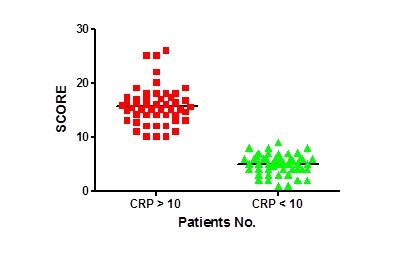
Comparison of SCORE values in the two groups
Analyzing the patients by their SCORE value, all the patients were divided in 2 categories: low to moderate risk (≤4%) and high to very high risk (>4%). In the low to moderate risk group, 81.2% of patients had the CRP level lower than 10mg/L, while with the same CRP level, only 11.1% were in the high to very high risk group for cardiovascular diseases.
Fig.2.
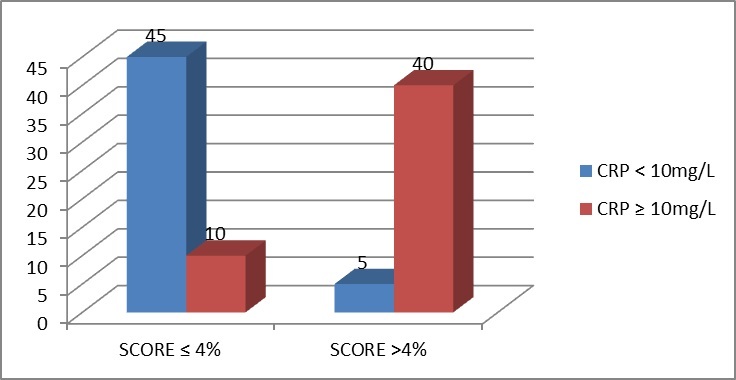
Frequency of patients with CRP<10 mg/l and CRP>10mg/l depending on SCORE
From the total of 100 patients, almost half of them are in the moderate risk category, and almost 40% in the high risk category, the rest of them (16%) are in the low and very high risc category.
Fig.3.
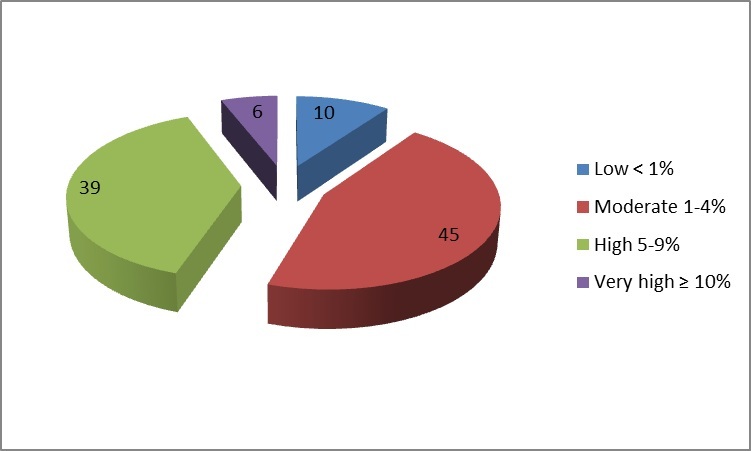
Group distribution by SCORE values
Analyzing the patients by their gender, in bouth groups A and B, there were more men than women. Gender does not influence SCORE values.
Fig.4.

Group distribution by gender
In group A, the average cholesterol value was 5.4±0.97mmol/L, in group B 8.6±1.44mmol/L, a statistical extremely significant difference was found between the average cholesterol level and CRP level, in group B were the patients had high CRP level, also the cholesterol level was higher, p value<0.0001.
Fig.5.
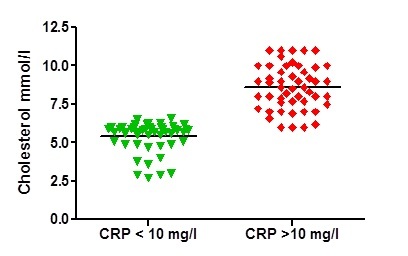
Comparison of average values of cholesterol depending on CRP levels
Looking at the average sistolic blood pressure in bouth groups, the patients with CRP<10mg/L had a mean sistolic blood pressure of 152±23.2 mmHg vs. 186±23.9mmHg seen at patients with CRP≥10mg/L, a statistically significant correlation was found betwen the high CRP levels and the average sistolic blood presure, p<0.05.
Fig.6.
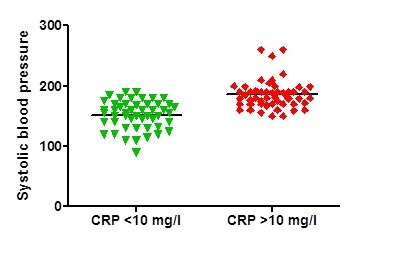
Comparison between average sistolic blood pressure values and CRP levels
No statistically significant difference was found between gender and cardiovascular risk categories evaluated with the SCORE chart, p=0.5413.
Discussion
The evaluation of CRP depending on SCORE values showed that high CRP levels lead to an increase of cardiovascular risk, evidenced by the fact that high CRP levels increase SCORE values. [6,7,8]
Our results are similar with those from the literature (European Heart Journal), which state that high C reactive protein values correlate with a high global cardiovascular risk. [9,10]
C reactive protein plays an important part in the immun response and is involved in the development and complications of atherosclerosis. The high level of C reactive protein is a powerful predictor of clinical events in healthy patients, diabetic patients, patients with medium or high cholesterol levels and patients with acute coronary syndromes. In order to evaluate cardiovascular risk, the threshold values of CRP are between 2-10mg/L in patients with acute coronary syndromes associated with a high risk of death. Risk stratification is an important step in the management of patients with acute coronary syndrome, and the current guidelines recommend the usage of the GRACE or SCORE scoring systems. The biological variables included in these scoring systems are creatinine and troponine serum levels, and C reactive protein levels are not taken into consideration. So far little is known about the addition of C reactive protein to the currently used scoring systems. The aim of this study was to determine the influence of C reactive protein levels on global cardiovascular risk with the help of the SCORE scoring system. [11,12,13]
The relation between high C reactive protein levels and atherosclerotic plaques, acceleration of thrombogenesis, decrease of nitric oxide synthesis, expression of adhesion molecules, alteration of complement functions and inhibition of physiological fibrinolysis were studied intensely. The clinical translation of these physiopathological effects has been studied in randomized clinical trials, such as „Fragmin during Instability in Coronary Artery Disease” (FRISC) and „Thrombosis in Myocardial Infarction” (TIMI), where patients with high C reactive protein levels had the worst results. High troponine and C reactive protein levels were associated with higher short-term mortality, with a threshold CRP level of 2mg/L. [14,15]
Additionally, the combination of a high risk score with high levels of C reactive protein may attract the physicians' attention to the importance of immediately initiating a high dose statine treatment to obtain low LDL cholesterol and C reactive protein levels, as demonstrated by the randomized studies and recommended by the guidelines. [13,15]
Our results confirm that the high level of C reactive protein is a modest but independent predictor of mortality, even after taking into consideration the comorbidities, hemodynamic conditions and used treatment. The integration of C reactive protein into the stratification of cardiovascular risk allows the improvement of risk classification.
Systemic Coronary Risk Evaluation (SCORE) is one of the most widely utilized risk scoring systems derived from the analysis of 12 European cohort studies and calculates the 10 year risk of cardiovascular death using 5 traditional risk factors: age, gender, systolic blood pressure values, cholesterol levels and smoking. By combining national mortality statistics SCORE also indicates the individualized risk level of each country. Patients with SCORE values≥5% are considered eligible for primary prevention. Although the vast majority of cardiovascular events occur in patients with at least one risk factor, the positive predictive value of traditional cardiovascular risk factors is rather low in healthy subjects. Because many patients have a SCORE value<5%, like in the present study, a large number of cardiovascular events may occur in this low risk group, determining the need to find new cardiovascular risk factors. The European Society of Cardiology recommends in its prevention guidelines that patients with markers of subclinical organ damage be placed in a higher risk category than the one calculated using SCORE. These markers are considered precursors and predictors of cardiovascular diseases and are an integrated part of the hypertension risk diagram of the European Society of Hypertension (ESH). [16,15]
In the apparently healthy population the presence of subclinical organ damage and the number of damaged organs is associated with a high cardiovascular risk that is independent of the SCORE values. The SCORE risk, combined with subclinical organ damage have a major influence on risk stratification and recommendations concerning primary prevention. [16]
The evaluation of subclinical organ damage has significantly improved risk stratification in studies performed on hypertensive patients, but there are no prospective studies concerning the healthy population. There were no interactions found between subclinical organ damage and hypertension, suggesting that subclinical organ damage has a predictive value that is equal in the hypertensive and normotensive population. [16]
In conclusion, subclinical organ damage indicates the risk of cardiovascular death independent of SCORE values, and their combination may improve the process of risk evaluation. [16]
Conclusions
C reactive protein levels higher than 10 mg/L correlate in a statistically significant manner (p<0.001) with a risk higher than 4% to develop a fatal cardiovascular event in the next 10 years. Its evaluation represents a highly useful method to establish cardiovascular risk, the results of the present study being in accordance with those from the literature. Nevertheless, we must not ignore the fact that 10% of patients with high cardiovascular risk had CRP values below 10 mg/L. This is probably due to the presence of other cardiovascular risk factors, ranging from behavioral habits to clinical and biological factors. We are talking about "traditional" risk factors: hypercholesterolemia, high LDL levels, low HDL levels, smoking, hypertension, obesity, diabetes, family history of ischemic cardiopathy, sedentary lifestyle, hyperuricemia, stress, type A personality, but also thrombogenic risk factors (high VII factor, high von Willebrand factor, high PAI-I, antithrombine III deficit, high homocystein levels, high Lp-A levels), inflammatory factors (high leukocyte levels, high fibrinogen levels, chronic infections, Helicobacter pylori), genetic factors (polymorphism of genes responsible for converting enzymes, apoprotein E, angiotensin). Also, a statistically significant correlation was found between the CRPs level and cholesterol levels (p<0.0001) and between the high CRP levels and the average sistolic blood presure, p<0.05.
It is certain that C reactive protein is a useful marker of atherosclerosis, efficient in the evaluation of global cardiovascular risk.
Glossary
ABBREVIATIONS
- CVD
cardiovascular disease
- CRP
C reactive protein
- SCORE
systematic coronary risk evaluation
- IL
interleukin
- LDL
low density lipoproteins
- CHD
coronary heart disease
- SD
standard deviation
References
- 1.Bonaca MP, Morrow DA. Defining a Role for Novel Biomarkers in Acute Coronary Syndromes. Clinical Chemistry. 2008;54:1424–1431. doi: 10.1373/clinchem.2008.105387. [DOI] [PubMed] [Google Scholar]
- 2.Ridker MP, Libby P. Novel Atherosclerotic Risk Factor; High-Sensitivity C-Reactive Protein. In: Libby P, Bonow R.O., Mann D.L., Zipes D.P., editors. Braunwald’s Heart Disease. A Textbook of Cardiovascular Medicine. 8. sss: Philadelphia; 2008. pp. 1012–1017. [Google Scholar]
- 3.Donald M, Kiang L, Lu Tian, et al. Assessment of C-Reactive Protein in Risk Prediction for Cardiovascular Disease. Annals of Internal Medicine. 2006 Jul 4;145(1):35–42. doi: 10.7326/0003-4819-145-1-200607040-00129. [DOI] [PubMed] [Google Scholar]
- 4.Cefalu TW, Cannon CP. Atlas of Cardiometabolic Risk. LOndon, UK: Informa Healthcare; pp. 87–94.pp. 127–132. [Google Scholar]
- 5.Graham I, Atar D, Borch-Johnsen K, et al. Ghidul European de Prevenţie a Bolilor Cardiovasculare în Practica Clinică. Revista Română de Cardiologie. 2007;XXII(4):370–418. [Google Scholar]
- 6.Folsom AR, Chambless LE, Ballantyne CM, et al. An Assessment of Incremental Coronary Risk Prediction Using C-Reactive Protein and Other Novel Risk Markers. The Atherosclerosis Risk in Communities Study. Arch Intern Med. 2006;166:1368–1373. doi: 10.1001/archinte.166.13.1368. [DOI] [PubMed] [Google Scholar]
- 7.Packard RR, Libby P. Inflammation in atherosclerosis: from vascular biology to biomarker discovery and risk prediction. Clin. Chem. 2008;54:24–38. doi: 10.1373/clinchem.2007.097360. [DOI] [PubMed] [Google Scholar]
- 8.Stern S. Are We Getting Nearer to Screening for Atherosclerosis? Circulation. 2008;117:122–126. doi: 10.1161/CIRCULATIONAHA.107.702381. [DOI] [PubMed] [Google Scholar]
- 9.Smith GD, Timpson N, Lawlor D. C-Reactive Protein and Cardiovascular Disease Risk: Still an Unknown Quantity? Annals of Internal Medicine. 2006 Jul 4;145(1):70–72. doi: 10.7326/0003-4819-145-1-200607040-00130. [DOI] [PubMed] [Google Scholar]
- 10.Wilson PVF, Nam BH, Pencina M, et al. C-Reactive Protein and Risk of Cardiovascular Disease in Men and Women From the Framingham Heart Study. Arch Intern Med. 2005;165:2473–2478. doi: 10.1001/archinte.165.21.2473. [DOI] [PubMed] [Google Scholar]
- 11.Serban M, Jurcut R, Cosmin M, et al. Inflamatia si riscul cardiovascular. Revista Română de Cardiologie. 2008;XXIII(2):157–161. [Google Scholar]
- 12.Chan YH, Lau KK, Yiu KH, et al. Reduction of C-reactive protein with isoflavone supplement reverses endothelial dysfunction in patients with ischaemic stroke. Euro Heart Journal. 2008;29(22):2800–2807. doi: 10.1093/eurheartj/ehn409. [DOI] [PubMed] [Google Scholar]
- 13.Grammer TB, Marz W, Renner W, et al. C-reactive protein genotypes associated with circulating C-reactive protein but not with angiographic coronary artery disease: the LURIC study. Euro Heart Journal. 2009;30(2):170–182. doi: 10.1093/eurheartj/ehn191. [DOI] [PubMed] [Google Scholar]
- 14.Ørn S, Manhenke C, Ueland T, et al. C-reactive protein, infarct size, microvascular obstruction, and left-ventricular remodelling following acute myocardial infarction. Euro Heart Journal. 2009;30(10):1180–1186. doi: 10.1093/eurheartj/ehp070. [DOI] [PubMed] [Google Scholar]
- 15.Schiele F, Meneveau N, Seronde MF, et al. C-reactive protein improves risk prediction in patients with acute coronary syndromes. Euro Heart Journal. 2010;31(3):290–297. doi: 10.1093/eurheartj/ehp273. [DOI] [PubMed] [Google Scholar]
- 16.Sehestedt T, Jeppesen J, Hansen TW, et al. Risk prediction is improved by adding markers of subclinical organ damage to SCORE. Euro Heart Journal. 2010;31(7):883–891. doi: 10.1093/eurheartj/ehp546. [DOI] [PubMed] [Google Scholar]


